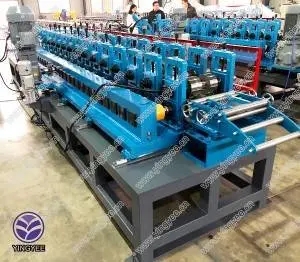
Roof Tile Production Line An Overview
The demand for durable and aesthetically pleasing building materials has led to extensive advancements in the roof tile production line. Roof tiles serve a vital role in protecting structures from various weather conditions, while also enhancing their visual appeal. This article delves into the intricate processes involved in the manufacturing of roof tiles, highlighting the significance of modern production lines.
At the outset, a roof tile production line begins with the selection of raw materials. Commonly used materials include clay, concrete, and certain types of metal. The chosen materials are essential for determining the durability, weight, and cost of the final product. In recent years, environmentally friendly materials have gained popularity, reflecting a growing trend towards sustainable construction practices.
Once the raw materials are sourced, they undergo a rigorous preparation process. For clay tiles, the clay must be finely ground and mixed with water to achieve the desired consistency. In contrast, concrete roof tiles require a mixture of cement, sand, and water, which is then blended thoroughly to guarantee a uniform product. The preparation phase is critical, as the quality of the mixture affects the strength and longevity of the tiles.
After preparation, the next phase involves molding the tiles into the desired shapes. This is typically achieved through either extrusion or pressing methods. Extrusion involves forcing the prepared material through a mold to create long strips, which are subsequently cut into individual tiles. Conversely, pressing employs a heavy hydraulic press to shape the material directly into tile forms. Both methods have their advantages, and the choice depends on the specific design and production capacity required.

Following molding, the tiles need to be cured to attain their final strength. For clay tiles, an intense firing process in a kiln is necessary, typically reaching temperatures between 900 to 1,100 degrees Celsius. This firing process helps achieve the characteristic hardness and color of fired clay tiles. On the other hand, concrete tiles are cured in a controlled environment, often using steam to accelerate the hardening process. This stage is crucial, as it ensures that the tiles can withstand environmental stresses once installed.
After curing, the tiles undergo quality control checks. Each batch is assessed for durability, finish, and color consistency. Advanced production lines often incorporate automated systems for precision and efficiency, reducing the likelihood of human error and enhancing overall product quality. Quality control is paramount, as it determines the longevity and performance of the roof tiles once they reach the market.
The final steps in the production line involve packing and shipping. Proper packaging is essential to protect the tiles from damage during transportation and handling. Manufacturers often employ palletizing robots to automate this process, ensuring efficiency and accuracy.
In conclusion, the roof tile production line is a sophisticated assembly of processes that transforms raw materials into vital construction elements. As the industry evolves, incorporating technology and sustainability into production practices, manufacturers are better equipped to meet consumer demands for quality, durability, and environmental responsibility. This not only benefits builders and homeowners but also contributes to greener construction practices worldwide. The roof tile production line stands as a testament to innovation and craftsmanship in the building materials sector, paving the way for future advancements.